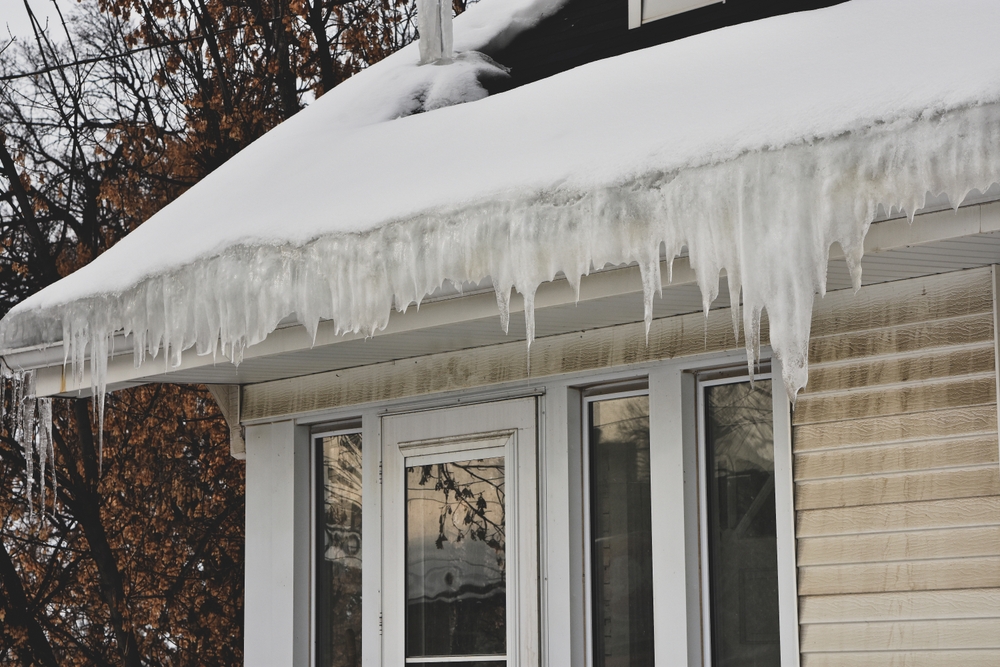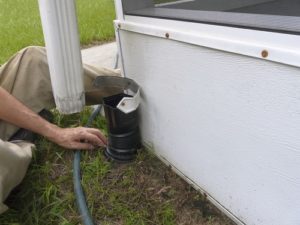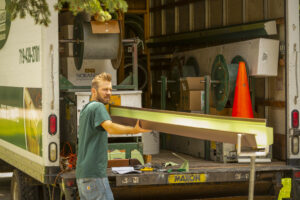Here in Colorado, it all starts with a clogged elbow in a dinky little 2”x3” downspout you forgot to clean out last October or a clog in your underground drain from all the grit that washed off your shingles over the summer. The first snow comes right about Halloween, and then we are blessed with a couple of days of beautiful 70-degree bluebird weather, and all the snow melts away. Where did all the melted snow off your roof go? It’ll sit in your downspout like a 10-foot tall column of water screwed to the side of your house, and it’s sitting in your gutter like a mini pond.
The Unseen Dangers of a Clogged Gutter
Now it’s getting into November, and it drops below freezing every night until spring, so what’s happening to all that water sitting in your gutters and downspouts? It’s freezing and thawing every single day and night, and when ice thaws it expands and cracks, just like dropping an ice cube popping when you drop it into a glass of water.
The Science Behind Ice Damming
When ice expands in your downspouts, it warps the aluminum and causes an aluminum tumor on the front side. On the back side, it splits the single-crimped seam that is butted up against your house, and when the spring rains come, all the water escapes directly onto the side of your home, causing damage to your siding and foundation.
Our patented brackets not only support 75 lbs but also allow our removable, reverse curve technology hood to mount on top of the gutter tested to handle 35 inches of rain per hour (something we haven’t seen in Colorado). This prevents clogging, as any debris small enough to make its way into our system will flush out through the 3”x4” downspout.
Although we can not claim that our curved hood will prevent all ice damming, we can guarantee that the propensity for it will be greatly reduced. The shape of the hood is designed to shed all solid materials to the ground and only allow water to flow into the gutter.
Understanding the Freeze-Thaw Cycle
As winter goes on, more snow comes with more thawing and freezing. By this point, the water and ice have backed up your downspout and have completely filled your gutters with an icy/water soup to the brim. The more snow that melts the more the water drips over the side of your gutter like a damn that has been breached. Then, the temperature drops below freezing while your overloaded gutters still leak, which is how icicles are born.
If you ever see icicles hanging from the side of a regular 5” open gutter (no screen or hood on top of, they are most likely attached to a solid block of ice inside the gutter. This is when the real problems start to happen. The weight of the ice can exceed 100 lbs depending on the length of the gutter run. Your gutters were designed to evacuate water, not support a bunch of weight 6-8 months per year. When the ice melts a little, the water works its way through the screw hole on the backside of your gutter w; here, your bracket is screwed to your fascia wood. This allows the wood to become wet and soft; eventually, the weight from the ice and snow can rip the gutters right off the side of your house. This can happen much quicker if the gutter is under a solar panel.
The expanding ice block inside the gutters can also stress the brackets, slowly causing the same effect. If your gutters don’t pull away and can withstand the weight, they can still slowly start to back-pitch. Back-pitching occurs when the opposite end from the downspout becomes weighted and begins to sag slowly. Eventually, the downspout becomes the highest point of elevation on your gutter. When the spring rains come around, the water can’t flow uphill, so it flows over the low end of your gutter and into your foundation, exactly like it would if it were clogged.
The Downward Spiral of Gutter Warping
Are your gutters warped or back-pitched? Go outside, stand back from your gutters about 20 feet, and look at the distance from the bottom of your fascia wood to the bottom of your gutter. Start at the opposite end from the downspout. The distance between the bottom of the wood and the bottom of the gutter should gradually decrease the closer you get to the downspout. If the distance between the bottom of the fascia wood and the bottom of the gutter undulates (gets wavy) as you go down the run, they also back pitch because they form multiple tiny bellies at the bottom of your gutter.
When Gutters Turn Cattywampus: Recognizing the Signs
Now, stand at one end of your gutter and look straight down the edge of the outside lip. Does it bow out in between the brackets, forming a wavy pattern? If your gutters are back-pitching and bow out in between brackets, they are “cattywampus.” Once they are cattywampus, they are usually past the point of diminishing returns on the lifetime of their structural integrity and function and should be replaced.
Once the ice has solidified in your gutters and is producing consistent icicles, the ice starts to back up onto your roof, working its way under each course of shingles and expanding and contracting with the temperature changes. This is what is known as “ice damming.” In Colorado, an impermeable membrane called anance and water shield must be installed under all shingles at the edge of the roofline, protecting the wood decking to which the shingles are mounted. However, the ice can still work under the shingle and expand, causing it to pop up and accelerate its wear and tear.
Prevention and Solutions
Early Winter Gutter Maintenance
How do you prevent all this from happening? First, take the downspouts apart and make sure they’re spotless going into winter, but sometimes that won’t help. If you have the tiny 2” x 3” downspouts, all it takes is an ice cube the same size as the one that comes out of your freezer to clog your whole system. You can install heat cables to melt the ice, but if your gutters are back-pitched, you’d only pay to have warm water held up against the side of your house all winter.
Ensure your gutters aren’t cattywampus going into winter because they’ll only worsen, and you will have a big mess when the spring rains come. You can get up on the ladder and clean out your gutters by hand; screens won’t help you as they sit flat; this gives the ice a platform to build on instead of building up inside the gutter, and now your gutters are too top-heavy and more likely to pull away. Screens also allow debris to work through like a cheese grater or clog themselves up, keeping everything out of your gutter, including the water.
You can hire the kid down the street to clean out your gutters, but be prepared for a lawsuit when he falls off the ladder and paralyzes himself, and his parents sue you for allowing it to happen. If you hire a gutter cleaning service, make sure they are licensed, bonded, and insured and inspect their work. Sometimes, they need to remember to clean out the downspouts.
K-Guard: The Ultimate Gutter Solution
The only REAL solution is K-Guard. We are a complete replacement gutter system with a double lifetime guarantee that it will never clog or pull away from your home. This includes back pitching. How can we make this claim? First, we use 3”x4” downspouts instead of the dinky little 2”x3” size. This is the difference between the drain on your toilet and your sink. Drain ahead, dump a five 5-gallon bucket of water into your sink, and watch how long it takes to drain; this happens to your gutters every time we get torrential spring rain. No matter how clean your downspout is, a 2”x3” downspout can’t handle it.
We use .032” thickness aluminum, the thickest you can bend without cracking our polymer-coated paint that has a limited lifetime warranty never to peel, chip, crack, rust, or blister. We take that .032” aluminum and crimp it twice on the backside of the downspout that touches your exterior wall. The double crimping would prevent the seam from splitting if ice were to expand inside your downspout. This prevents water from escaping onto the side of our house and foundation during the spring, summer, and fall rains.
We use high-density polyurethane brackets every two feet; each bracket supports 75 lbs. Our bracket has a patented design so that no matter how high the water fills in the gutter, it will never reach the elevation of the screw and wick back into your wood. The back of the gutter is higher than the front, making it impossible for water to get behind it. Your fascia wood stays completely dry as long as our system is on your home, and our patented bracket allows us to provide a lifetime no pull-away guarantee, or we can come to pair or replace it.
A by-product of shedding the ice and snow off of our roof is that you will see icicles forming on the edge of the lip of your hood cover. This is a normal thing to see with a hood cover. With K-Guard, the icicles form 5.75” away from your shingle edge and are not attached to a solid block of ice inside the gutter. Once the sun comes out and warms the aluminum, the icicles burn off. The drip from the icicles, as they are burning off, will never be enough to damage your foundation. In certain problem areas, like on north-facing walkways where safety may be of concern, we are the only company that can come back and remove the hood and install a heat cable under the hood (using thermal tape to hold it in place) in the gutter trough and the downspouts. This causes the snow to melt and evacuate as soon as it contacts our system.
The Long-Term Benefits of a K-Guard Installation
We can also install standard 5” open gutters on your home without the hood. Although we can’t guarantee a lifetime, no-clog, and no-pull-away warranty on our open gutters, we ensure you will see many more years of proper functionality due to our larger downspouts, thicker aluminum, and reinforced steel brackets every 2 feet.
If you want to damage your icicles and ice by damming a distant memory, we are the product for you.
Contact us today and have one of our specialists come out for a free evaluation and estimate on your home.




